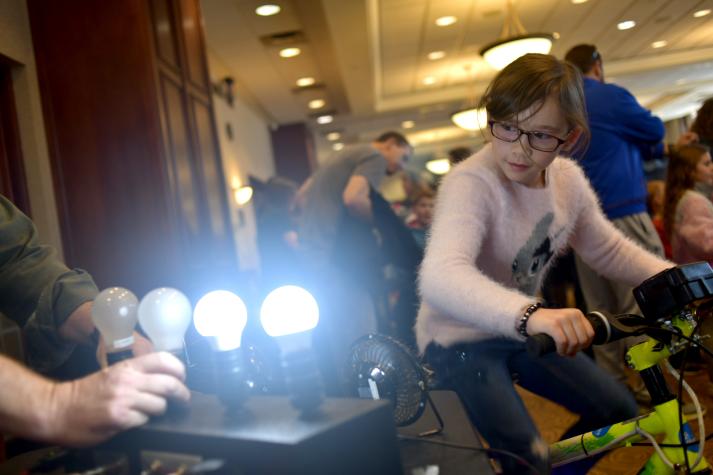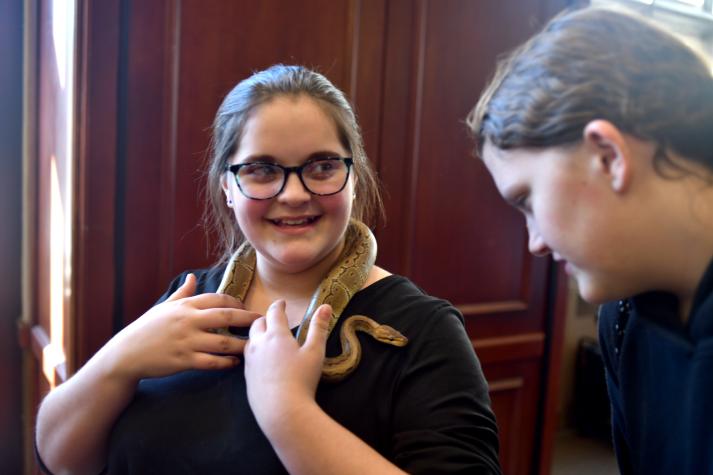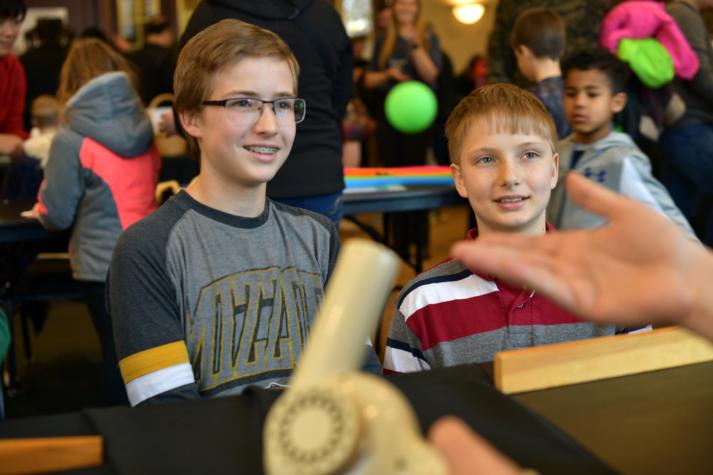COLUMBIA, Mo. – More than 600 young scientists and their families joined University of Missouri researchers Feb. 7 at the second annual Columbia Young Scientists Expo, sponsored by The Connector, a program that builds relationships between researchers and communities. Scientists, graduate students and others shared demonstrations and presentations during the afternoon event at the Memorial Union at Mizzou.
“Events like this allow the Columbia community to see and experience some of the research being done on Mizzou's campus in a fun and engaging way,” said Rachel Bauer, engagement programs manager for The Connector.
Among the attendees was 13-year-old Cali Davis, who said science is her thing. “I ask a lot of questions at school. Scientists are constantly asking questions.” She was also on campus that day for a science fair, where she examined the question “Can water float on water?” (Spoiler: It can—warm water will float on cold water because it’s less dense. Freshwater floats on saltwater for the same reason.)
One of the more popular exhibits let attendees generate electricity by pedaling a stationary bicycle. A row of light bulbs connected to the bike vividly demonstrates the energy efficiency of LED lights compared to more power-hungry incandescent bulbs. When 8-year-old Alyssa Chiang got her turn on the bike, the LEDs glowed brightly while the incandescent lights remained dim despite furious pedaling.
Sam Schultz, 14, has always wanted to go to space. He got a taste of the final frontier thanks to a VR space station simulator. Sam was also a participant in the science fair and was excited about winning first place in his competition. He measured the speed of light. “I measured the speed of light with gelatin, a protractor and a laser pointer. And a whole lot of math.” Just how fast is light? He got the correct answer to two decimal places: 2.99 x 108 meters per second. That’s 185,789.99 miles, which is more than three quarters of the distance to the moon.
Casey Holliday, associate professor in Pathology and Anatomical Sciences at the MU School of Medicine, introduced visitors to a replica of part of a Tyrannosaurus rex’s jawbone. The original skeleton, named Stan, is at the Black Hills Geological Institute in South Dakota. Holliday’s lab studies the relationship between form and function in archosaurs, a group of animals that includes dinosaurs as well as birds, crocodiles and alligators.
“This is a unique experience for both parents and kids to grow their interest in science while learning about some of the cutting-edge research happening at Mizzou,” Bauer said. “As a land-grant institution, it's so important for our scientists to share their expertise with the people of Missouri.”
Photos available for this release:
Alyssa Chiang pedaling a bike to generate electricity
Alyssa Chiang, 8, turns muscle power into electricity at the recent Columbia Young Scientists Expo. The bulbs on the right are brighter because they are more energy efficient. It takes a lot more effort to make the incandescent bulbs glow. Photo by Michael Hicks.
Cali Davis with a python on her shoulders as Jordan McManus looks on warily
Cali Davis, 13, left, says science is her thing. "I ask a lot of questions at school. Scientists are constantly asking questions.” Her friend, Jordan McManus, 13, eyes the python warily. Photo by Michael Hicks.
Nathaniel Kauffman and Elijah Kauffman
Nathaniel Kauffman, 13, left, and Elijah Kauffman, 10, are learning that the ball stays in the air even if the hair dryer is tilted because the ball floats within a column of faster-moving, lower-pressure air. The same principle creates lift under an airplane’s wings. Photo by Michael Hicks.
Casey Holliday displays a replica of part of the jawbone of a T. rex
Casey Holliday, associate professor in the MU School of Medicine, displays a replica of part of the jawbone of a T. rex. The original skeleton, named Stan, is in South Dakota. Photo by Michael Hicks.



